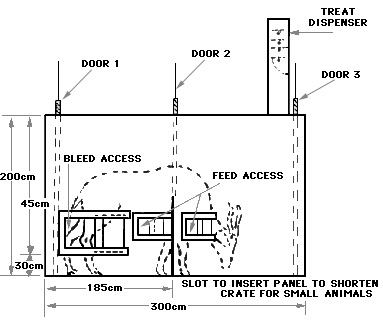

The procedures used for training both the nyala and the bongo were very similar. For both species, a stout plywood crate similar to the shipping crate was placed in the animal's indoor living quarters. The dimensions of the crate for nyala was 198 cm long, 109 cm high and 40 cm wide (Grandin et al., 1995). The bongo crate had outside dimensions of 300 cm long, 200 cm high and 60 cm wide. The crates were equipped with plywood vertical slide doors on each end.
The doors could be operated by cables and pulleys. Both the bongo and the nyala crates were equipped with a middle sliding door which could be used to shorten the crate for smaller animals. For both species, the crates had sufficient length so that an animal had to be completely inside the crate to reach food place on the floor in the front of the crate. This prevented the animals from stretching and keeping their rear legs outside the crate to reach food placed on the floor in the front of the cart. The drawing shows the location of openings in the bongo crate to access the rear leg for blood sampling and for feeding treats to the animals.

The crates were positioned in the entrance and exit door of the nyala and bongo barns. When the barn door was closed against the crates, the animals had to walk through the crate to go to the outdoor exhibit. During the first seven days of training, the barn door was left open to allow the animals to become habituated to the crate being in their stall before it was positioned so they had to walk through it.